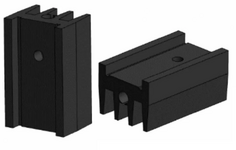tyilgin
Junior Member level 2
Hi,
I have used triacs a few times in my work so far, and I have always used these triacs with the 57AS coolers shown in the picture in the TO220 case. The current flowing through it was never more than 5 amps.
I've never felt the need to monitor it in detail, but I've never noticed that the coolers got so hot that they became uncomfortable when touched.
Now I am thinking of using the triacs in the DPAK/D2PACK case, but I am doing research on whether the 1cm2 copper area I drew on the PCB will be sufficient for cooling.
Unfortunately, since I do not have the knowledge or equipment to evaluate the formulas I found as a result of my research, I could not understand them even though I found a few online calculation sites.
Could I please ask your opinions on whether 1cm2 copper area will be enough to cool my triac (Ex. BT137B-800G) under a 5A load?
I have used triacs a few times in my work so far, and I have always used these triacs with the 57AS coolers shown in the picture in the TO220 case. The current flowing through it was never more than 5 amps.
I've never felt the need to monitor it in detail, but I've never noticed that the coolers got so hot that they became uncomfortable when touched.
Now I am thinking of using the triacs in the DPAK/D2PACK case, but I am doing research on whether the 1cm2 copper area I drew on the PCB will be sufficient for cooling.
Unfortunately, since I do not have the knowledge or equipment to evaluate the formulas I found as a result of my research, I could not understand them even though I found a few online calculation sites.
Could I please ask your opinions on whether 1cm2 copper area will be enough to cool my triac (Ex. BT137B-800G) under a 5A load?
